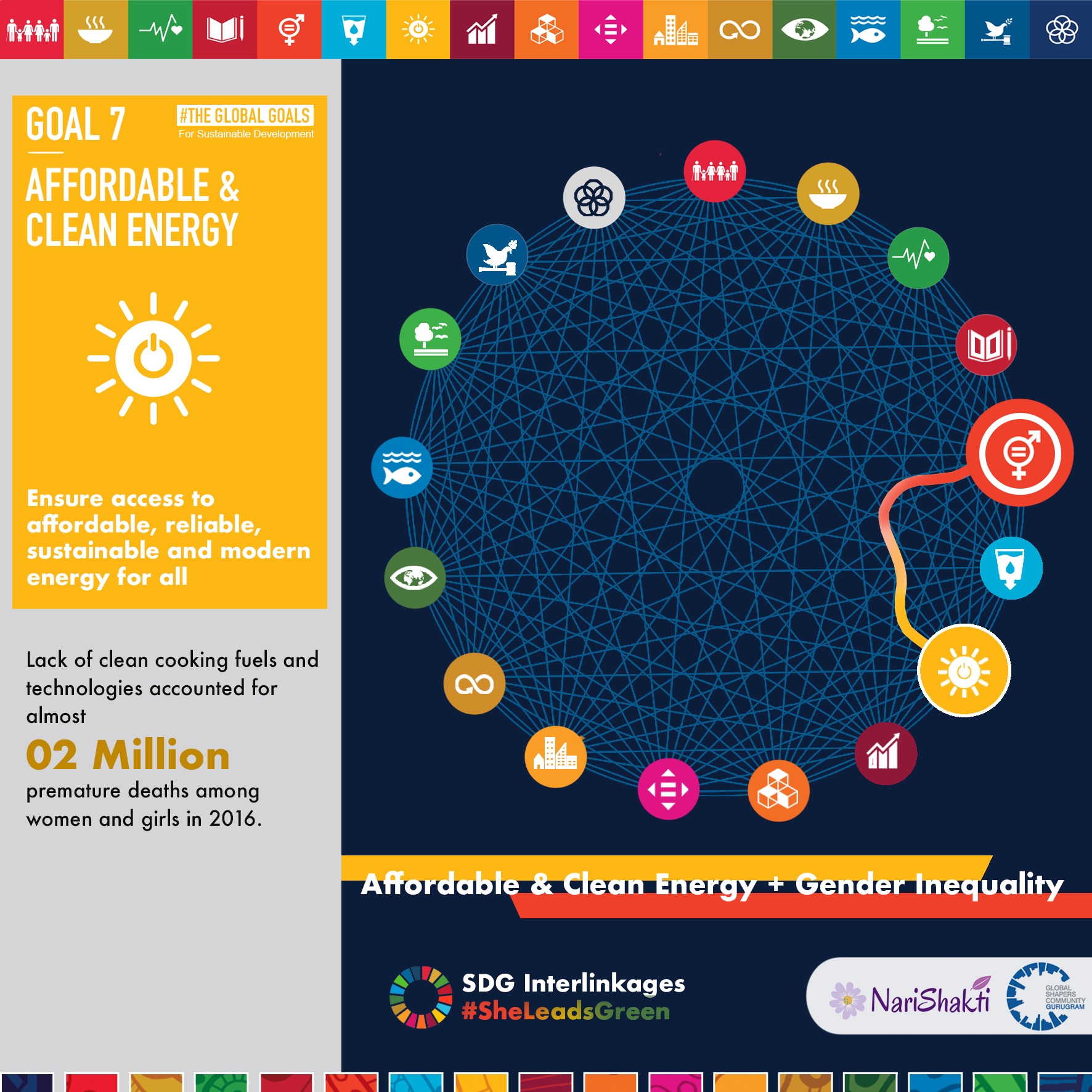
Gender parity for clean, affordable energy (SDG 7)

This article is compiled by taking references of work done by our knowledge partners ReNew Foundation and Barefoot College International in energy space.
Why do we need to look at clean energy from a gender lens?
- With energy poverty plaguing around 300 million Indians, it is important to look at access to clean and affordable energy through a gender lens, given that a large majority of people who have no access are women. When you look at the stats globally, we realize that a large chunk of the 1.1 billion people are women.
- Around 3 billion people worldwide, mostly women, use traditional fuels like wood or kerosene for indoor cooking, which exacerbates indoor pollution, and the deaths caused by it. In fact, out of the 4.3 million people who died prematurely out of indoor pollution due to cooking from solid fuels in 2012, 60% were women and girls.
- We also need to look through the gender lens, because women and girls are primary household energy managers, and the lack of clean and affordable energy makes women and girls spend hours collecting solid unsustainable fuel sources such as wood, spending almost 18 hours a week in this activity. Also, only 20% of the workforce in industries producing modern clean energy are women.
- It is also empirically proven that women conserve 22% more energy than men, making them adept at energy planning. Therefore gender-inclusive energy planning becomes critical during pursuits to fulfill the targets of SDG 7, warranting the need to look at clean and affordable energy access through a gender lens.
How is clean, affordable energy and gender-linked?
- Gender (SDG 5) and clean energy access (SDG 7) are interlinked when we consider the fact that women and girls are the primary procurers and users of energy in households. There aren’t any gender-specific indicators in SDG 7, however, prominent initiatives worldwide have focused on improving gender parity through interventions like training of women to become solar engineers (like Solar Mamas, or Barefoot College’s work in Rajasthan).
- Women in rural areas spend a large quantum of time weekly to procure unsustainable energy, therefore by providing access to clean and affordable energy, women will inevitably benefit as it will save a lot of time and effort on their part spent on procuring energy.
- Also, as mentioned earlier, indoor pollution has been the cause of death of a large number of people annually, out of which 6 out of 10 people who die are women, therefore lack of clean cooking fuels poses a major risk to the health of women and girls in rural areas who face the brunt of indoor pollution.
- Therefore access to clean energy and gender equality is intrinsically linked, given the current energy dynamics in households, especially rural ones.
What outcomes in SDG 7 can be achieved if we reach gender parity?
“As old woman things were difficult for me. I lived in darkness throughout my life, and on top of that with poor eyesight, I had to come home early after working as a maid in just two houses and relying on expensive kerosene lamps at my own house. With ReNew Power bringing the community micro-grid here, I am able to work longer hours and save money spent on kerosene. I can work at more houses as well and can support my family. I will always be grateful to ReNew Power for truly bringing light to my life”
~ Radha Rajbhar, Paniyara, 60 years old
- As the clean energy sector is widely regarded as one of the least gender-diverse parts of the economy, it is the need of the hour that the sector needs to shift the dial by drawing on all talents to deliver a secure, affordable, and sustainable energy future for all.
- Reports clearly suggest that bridging the gender gap will be vital as women are key drivers of innovative, inclusive solutions and business models which is critical for transitioning towards clean energy.
- International Renewable Energy Agency (IRENA) in its report on looking at renewable energy from a gender perspective highlights that as women get engaged in delivering energy solutions, they take on more active roles in their communities and consequently facilitate a gradual shift in the social and cultural norms that previously act as barriers to the organization.
- There is also growing evidence that greater gender diversity— particularly on boards and in other leadership positions in the energy sector benefits businesses in meaningful financial and non-financial terms, such as through improved profitability and innovation capacity (Ernst and Young, 2016; World Bank ESMAP, 2018).
There are some notable organizations working in this space to achieve the targets of SDG 7 keeping women in mind. For building resilient, sustainable, and climatically just rural villages, Barefoot College International is currently working in 20 districts across India. Thus bringing clean energy access to 41,652 people whilst replacing a whopping 6497 smoke-guzzling kerosene lamps cutting CO2 emissions by 4039 metric tonnes. To know more about the initiative, visit https://www.barefootcollege.org/aspirational-districts-an-update-on-our-current-work
References:
- https://www.unwomen.org/-/media/headquarters/attachments/sections/library/publications/2019/progress-on-the-sdgs-the-gender-snapshot-2019-single-pages-en.pdf?la=en&vs=5813
- https://www.unwomen.org/en/news/in-focus/women-and-the-sdgs/sdg-7-affordable-clean-energy
- https://www.irena.org/-/media/Files/IRENA/Agency/Publication/2019/Jan/IRENA_Gender_perspective_2019.pdf
- https://wedocs.unep.org/bitstream/handle/20.500.11822/25185/sdG_Brief_002_gender.pdf?sequence=1&isAllowed=y
- https://openknowledge. worldbank.org/handle/10986/29259


